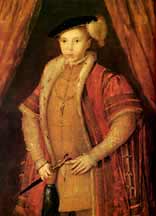 Edward VI
Edward VIHouse of Tudor -- Reigned: 1547-1553 1537-1553
Edward's reign was beset by problems from the onset. Ascending the throne while still in his minority presented a backdrop for factional in fighting and power plays. Henry VIII, in his last days, sought to eliminate this potential problem by decreeing that a Council of Regency would govern until the child came of age, but Edward Seymour (Edward VI's uncle) gained the upper hand. The Council offered Seymour the Protectorship of the realm and the Dukedom of Somerset; he genuinely cared for both the boy and the realm, but used the Protectorship, as well as Edward's religious radicalism, to further his Protestant interests. The Book of Common Prayer, the eloquent work of Archbishop Thomas Cranmer, was instituted in 1549 as a handbook to the new style of worship that skated controversial issues in an effort to pacify Catholics. Henrician treason and heresy laws were repealed, transforming England into a haven for continental heretics. Catholics were pleased with the softer version of Protestantism, but radical Protestants clamored for further reforms, adding to the ever-present factional discord. Economic hardship plagued England during Edward's rule and foreign relations were in a state of disarray. The new faith and the dissolution of the monasteries left a considerable amount of ecclesiastical officials out of work, at a time when unemployment soared; enclosure of monastic lands deprived many peasants of their means of subsistence. The coinage lost value as new coins were minted from inferior metals, as specie from the New World flooded English markets. A French/Scottish alliance threatened England, prompting Somerset to invade Scotland, where Scottish forces were trounced at Pinkie. Then general unrest and factional maneuvering proved Somerset's undoing; he was executed in September 1552. Thus began one of the most corrupt eras of English political history. The author of this corruption was the Earl of Warwick, John Dudley. Dudley was an ambitious political survivor driven by the desire to become the largest landowner in England. Dudley coerced Edward by claiming that the boy had reached manhood on his 12th birthday and was now ready to rule; Dudley also held Edward's purse strings. Dudley was created Duke of Northumberland and virtually ruled England, although he had no official title. The Council, under his leadership, systematically confiscated church territories, as the recent wave of radical Protestantism seemed a logical, and justifiable, continuation of Henrician reform. Northumberland's ambitions grew in proportion to his gains of power: he desperately sought to connect himself to the royal family. Northumberland was given the opportunity to indulge in king making -- the practice by which an influential noble named the next successor, such as Richard Neville during the Wars of the Roses -- when Edward was diagnosed with consumption in January 1553. Henry VIII named the line of succession in his will; next in line after Edward were his sisters Mary and Elizabeth, followed by the descendants of Henry's sister, Mary: Frances Grey and her children. Northumberland convinced Edward that his Catholic sister, Mary, would ruin the Protestant reforms enacted throughout the reign; in actuality, he knew Mary would restore Catholicism and return the confiscated Church territories which were making the Council very rich. Northumberland's appeal to Edward's radicalism worked as intended: the dying lad declared his sisters to be bastards and passed the succession to Frances Grey's daughter, Lady Jane Grey, one of the boy's only true friends. Northumberland impelled the Greys to consent to a marriage between his son, Guildford and Lady Jane. Edward died on July 6, 1553, leaving a disputed succession. Jane, against her wishes, was declared queen by the Council. Mary retreated to Framlingham in Suffolk and claimed the throne. Northumberland took an army to capture Mary, but bungled the escapade. The Council abandoned Northumberland as Mary collected popular support and rode triumphantly into London. Jane after a reign of only nine days, was imprisoned in the Tower of London until her 1554 execution at the hands of her cousin Mary. Edward was a highly intellectual and pious lad who fell prey to the machinations of his powerful Council of Regency. His frailty led to an early death. Had he lived into manhood, he potentially could have become one of England's greatest kings. Jane Austen wrote, "This Man was on the whole of a very amiable character . . .", to which Beckett added, "as docile as a lamb, if indeed his gentleness did not amount to absolute sheepishness." |
All rights reserved. For details and contact information: See License Agreement, Copyright Notice. |
 Edward VI, son of
Edward VI, son of